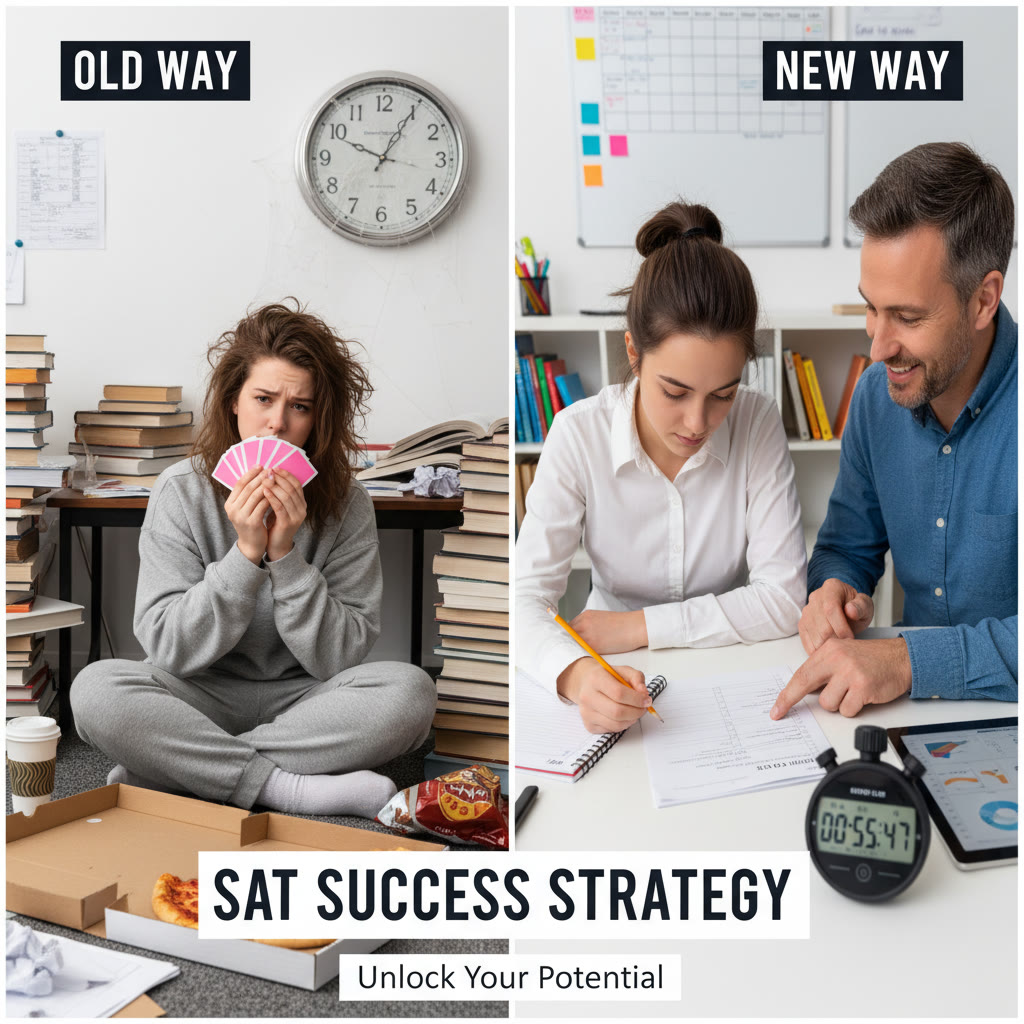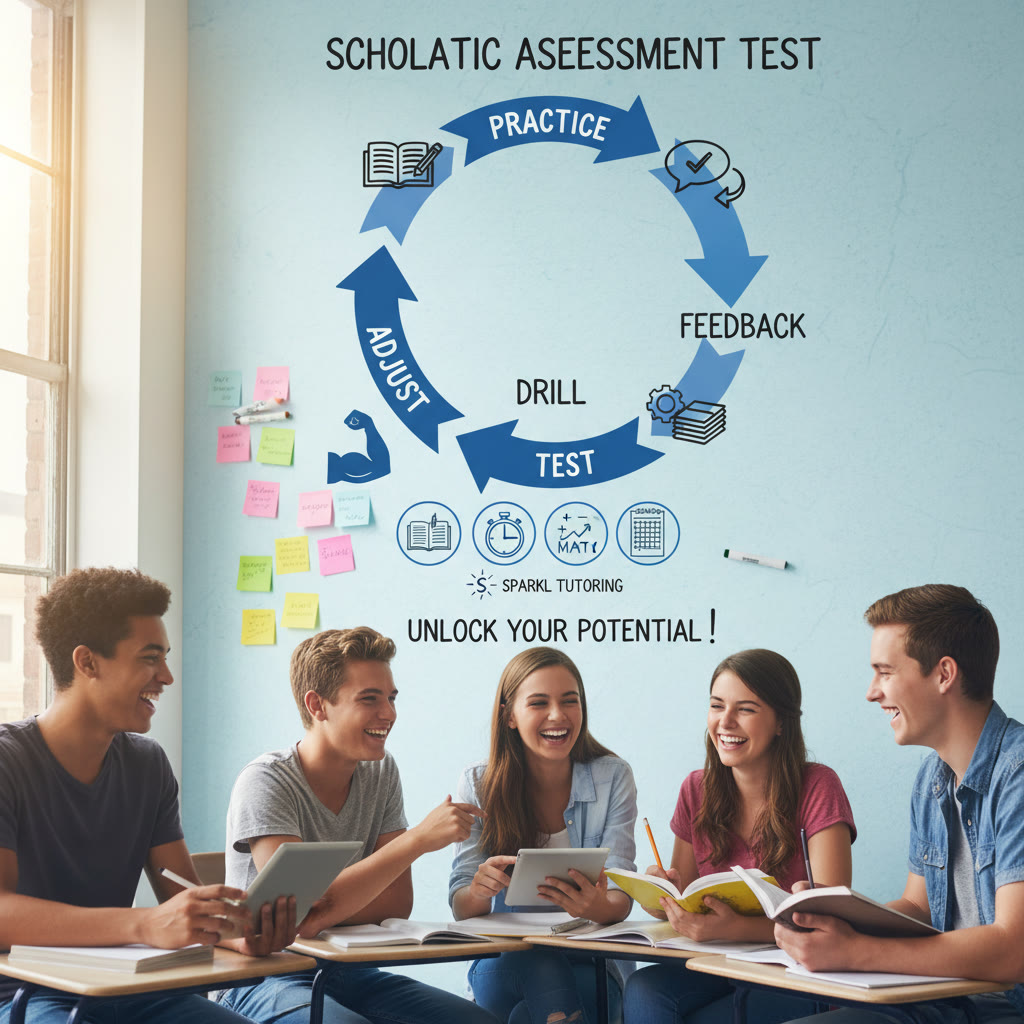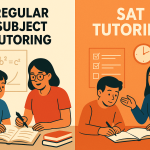Why thinking of the SAT as a skill changes everything
Most students approach the SAT like a vocabulary list or a stack of math formulas: memorize the words, memorize the rules, and hope it clicks on test day. That strategy can yield short-term gains, but it often stalls. The SAT isn’t just a pile of content — it’s a performance made up of repeatable skills: pattern recognition, pacing, argument analysis, error diagnosis, endurance, and strategic guessing. When you treat the SAT as a skill to be trained, you stop chasing an endless list of facts and start practicing habits that transfer across every section.
What do we mean by a skill?
Think about a sport. You don’t win a tennis match by memorizing the rules; you win by developing strokes, footwork, and match sense through practice. The SAT works the same way. A skill is something you can rehearse, get feedback on, refine, and apply reliably under pressure. For the SAT, those skills include:
- Active reading and inference: spotting an author’s tone, structure, and implicit claims quickly.
- Pattern-based math thinking: recognizing problem templates and reducing unusual wording to familiar math.
- Timing and pacing: allocating minutes so you finish each section without reckless guessing.
- Error analysis: diagnosing why you missed a question and fixing the root cause.
- Test resilience: staying calm when the unexpected appears and bouncing back from mistakes.
Skill vs content: the practical differences
If you focus on content, your checklist looks like this: learn grammar rules, memorize geometry theorems, add to vocabulary lists. These are important, but alone they’re not enough. Shift your view and the checklist becomes: practice applying grammar under time pressure, recognize when a geometry problem is a disguised algebra problem, learn how to eliminate wrong answer traps fast.
Table: Skill-based vs Content-based approaches
| Approach | What you do | Typical outcome |
|---|---|---|
| Content-based | Memorize rules, review concepts, passive reading | Knowledge increases, but performance under timed conditions varies |
| Skill-based | Targeted practice, timed drills, error analysis, strategy rehearsal | Reliable application on test day and sustainable score gains |
How to build SAT skills: practical steps
Turning knowledge into skill is a science: break tasks into subskills, practice deliberately, get feedback, and repeat. Here are the core steps with examples you can adopt right away.
1. Break sections into micro-skills
Each SAT section hides several micro-skills. Identify them and practice each one deliberately.
- Reading: main idea extraction, evidence-finding, inference-making, tone recognition.
- Writing & Language: sentence-level clarity, parallelism, punctuation choices, rhetorical structure.
- Math: algebra translation, number sense, geometry visualization, problem simplification.
Example: for Reading, spend a week practicing only evidence questions. Time yourself for small clusters (3–4 questions), underline precise lines in the passage, and practice restating the evidence in one sentence. That repetition builds the muscle of finding exact lines — a transferable skill across passages.
2. Use deliberate practice, not busywork
Deliberate practice means focused drills with clear goals and immediate feedback. That might look like:
- Doing 20 targeted Writing & Language questions focused exclusively on parallelism, then reviewing each error.
- Timing 10 algebra questions to 1.5 minutes each, learning the fastest path to the solution, and trying again until your time improves.
One key: reduce the scope so you can see progress. Doing entire practice tests is important for stamina, but if you only ever take full tests you’ll miss the chance to zero in on weak micro-skills.
3. Keep an error log — and use it strategically
An error log isn’t just a list of wrong answers; it’s a diagnostic tool. For each mistake, write:
- Question type and section
- Exact reason for the error (rushed, concept gap, misread wording, silly arithmetic)
- What you’ll do to fix it (targeted drill, re-learn a rule, slow down)
- When you’ll retest this type
Over time, patterns emerge. Maybe you lose points on double-negative constructions in Writing, or you consistently make arithmetic mistakes when fractions appear. Those patterns tell you where to spend your energy.
4. Emphasize timing strategies and pacing
Timing is a skill you can improve without changing your knowledge. Learn pacing for each section, and practice with a watch or timer. Some practical pacing tips:
- Reading: read the first paragraph and the first sentence of each subsequent paragraph, then scan for evidence lines. Don’t read line-by-line unless needed.
- Writing: prioritize questions that are sentence-level first, then passage-wide rhetorical questions; learn to spot the 3–4 common error types.
- Math: do the easiest problems first — know your threshold for what you can solve quickly vs what you should skip to the end.
A useful drill: give yourself a strict time limit for each block of questions and review only the ones you missed. Gradually reduce the time while maintaining accuracy.
Sample weekly skill-based practice plan (table)
This sample plan balances skill drilling, full-length practice, and review time. Adjust hours to fit your week.
| Day | Focus | Activities | Time |
|---|---|---|---|
| Monday | Reading micro-skills | 3 short passages focused on evidence questions; error log update | 90 min |
| Tuesday | Math pattern recognition | Targeted drills: algebra translation, quadratic patterns; timed sets | 90 min |
| Wednesday | Writing accuracy | 40 targeted Writing questions (parallelism, punctuation); review mistakes | 75 min |
| Thursday | Mixed timed practice | Half practice test (three sections) with strict timing; error log | 120 min |
| Friday | Weak-skill remediation | Drills based on the week’s error patterns; 1-on-1 coaching session if available | 60–90 min |
| Saturday | Full-length test or stamina build | Full practice test every 2–3 weeks; otherwise, extended timed reading/math sets | 4 hours |
| Sunday | Reflection and rest | Review error log, plan the next week, light vocabulary/mental break | 45 min |
Examples: turning content into skill
Let’s walk through two concrete examples — one from Reading and one from Math — to show how a content item becomes an actionable skill.
Reading example: “evidence line” skill
Content view: learn what “evidence-based” questions ask. Skill view: train yourself to recover the exact sentence that supports the answer in under 30 seconds.
Practice drill:
- Choose a passage and isolate every question that asks for evidence.
- Before looking at the choices, underline the single sentence that best supports the target idea.
- Compare your sentence with the correct answer choice and note differences in precision. Were you too general? Too specific?
- Log mistakes and repeat with a new passage the next day.
Result: after several sessions, you’ll find evidence questions take only a fraction of the time because you build a reliable way to find and paraphrase the supporting line.
Math example: transforming algebra rules into strategy
Content view: memorize how to solve systems of equations. Skill view: when a word problem shows two related conditions, instantly map it to a system and decide the fastest solution method (substitution, elimination, or clever manipulation).
Practice drill:
- Pull 15 word problems that hide systems of equations.
- For each, decide on paper in 30 seconds which method will be fastest and why.
- Solve only those chosen with a strict time cap, then reflect on whether your method choice saved time.
Result: you stop reinventing the wheel for each problem and develop an instinct for recognizing the fastest path — a skill that saves minutes on test day.
The role of feedback and coaching
Skills need feedback. Practicing without correction means you might solidify bad habits. That’s where coaching — human or AI-assisted — becomes invaluable. A good coach helps you:
- Interpret patterns in your error log
- Design micro-drills that address root causes
- Push your pacing limits safely with realistic timing pressure
- Calibrate strategy choices under simulated test stress
Sparkl’s personalized tutoring and benefits — including 1-on-1 guidance, tailored study plans, expert tutors, and AI-driven insights — can fit naturally into this process. Tutors help translate mistakes into high-impact practice, and AI-driven insights can highlight the patterns you might miss on your own. The point is not to outsource practice; it’s to sharpen it with informed feedback.
When to seek help
If you’ve been practicing and your score plateaus, consider targeted coaching. Look for help that focuses on skill-building — not just content review. Ask potential tutors how they:
- Diagnose skill gaps
- Create drills to shore up those gaps
- Use data (your past tests) to adjust the plan
Common pitfalls when training SAT skills
Even when students try to focus on skills, they fall into traps. Here are four common pitfalls and how to avoid them.
Pitfall 1: Mistaking repetition for improvement
Doing the same problem types repeatedly without tweaking the difficulty or changing the constraints leads to familiarity, not skill. Solution: vary contexts, add timing pressure, and change constraints so the skill generalizes.
Pitfall 2: Never reviewing correct answers
It’s tempting to focus only on wrong answers, but studying why correct answers work — especially closely wrong-looking distractors — strengthens decision-making. Solution: analyze close-call items and the small differences that make one choice right.
Pitfall 3: Ignoring mental conditioning
Stamina and stress management are less glamorous but essential. A brilliant test-day spike can be undone by fatigue or anxiety. Solution: simulate test conditions periodically and practice relaxation and focus techniques (short breathing exercises, scheduled breaks, and realistic test pacing).
Pitfall 4: Copying someone else’s plan exactly
No two students are the same. What worked for a friend may not address your error patterns. Solution: use sample plans for structure, but personalize them based on your error log and learning preferences.
How progress looks: realistic expectations
Skill development is incremental and sometimes nonlinear. You’ll have days of sudden clarity and weeks where progress feels invisible. Track progress in multiple ways:
- Raw practice test scores
- Speed and accuracy on timed micro-drills
- Reduction in repeat error types in your log
- Confidence and stress levels during simulated testing
Small, measurable improvements in micro-skills compound into meaningful score gains over 6–12 weeks of deliberate practice. The key is consistency and an emphasis on feedback loops.
Putting it together: a mini case study
Imagine Maya, a junior who scored a 1210 on her first practice test. Her main issues were low reading pace and careless math errors. Instead of a general study plan, she did three things:
- Built a reading micro-skill schedule: evidence drills three times weekly, timed paragraph summaries, and focused vocabulary in context.
- Kept a strict math error log: every arithmetic slip or sign mistake was annotated with a cause and a specific drill for prevention.
- Worked with a tutor twice a week for targeted feedback and weekly plan adjustments; the tutor used practice data to recommend AI-identified drills for weak areas.
After ten weeks, Maya’s timed reading speed improved, her careless errors dropped dramatically, and her practice scores rose to a consistent 1320–1360 range. Her improvement didn’t come from cramming more facts; it came from transforming behaviors and decision-making into repeatable skills.
Final checklist: Are you training the SAT as a skill?
- Do you maintain an error log and act on patterns?
- Are you practicing micro-skills with time pressure and feedback?
- Do you periodically simulate full tests to build stamina?
- Are you using coaching or technology to get targeted, data-driven feedback?
- Do you adjust your plan based on results, not on what feels good?
If you answered yes to most of these, you’re on the right track. If not, pick one skill to focus on this week and design a deliberate practice routine around it.
Two image ideas to illustrate the concept


Closing thought: skill-building is empowering
Approaching the SAT as a skill demystifies the test. It turns vague anxiety into precise actions and vague effort into measurable progress. You’ll stop feeling like you’re at the mercy of arbitrary questions and start controlling the parts of the test you can influence. With focused practice, honest feedback, and the right coaching tools — like Sparkl’s personalized tutoring and benefits such as 1-on-1 guidance, tailored study plans, expert tutors, and AI-driven insights — the SAT becomes less of a guessing game and more of a stage where your practiced skills shine. That’s not just a test strategy; it’s a smarter way to learn that will serve you beyond college admissions.
Ready to treat the SAT like a skill and not just content? Pick one micro-skill today, set a 30-minute focused practice block, and commit to reflecting on mistakes with an error log. Skill-building starts small — and it compounds faster than you think.















No Comments
Leave a comment Cancel